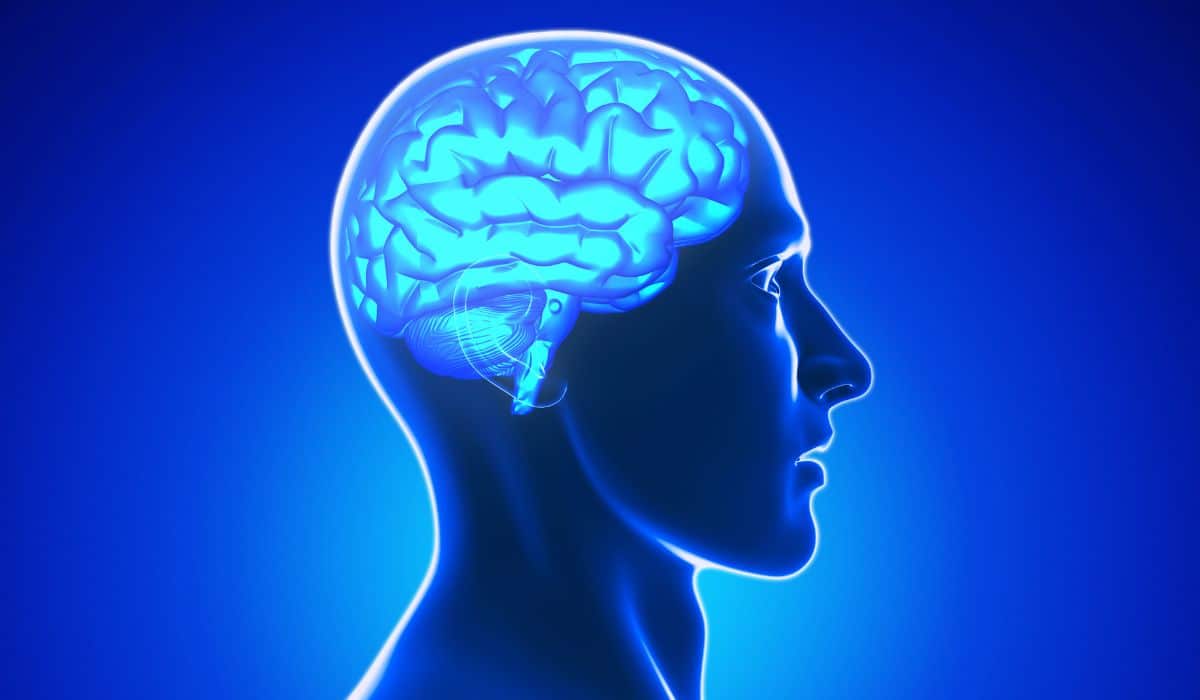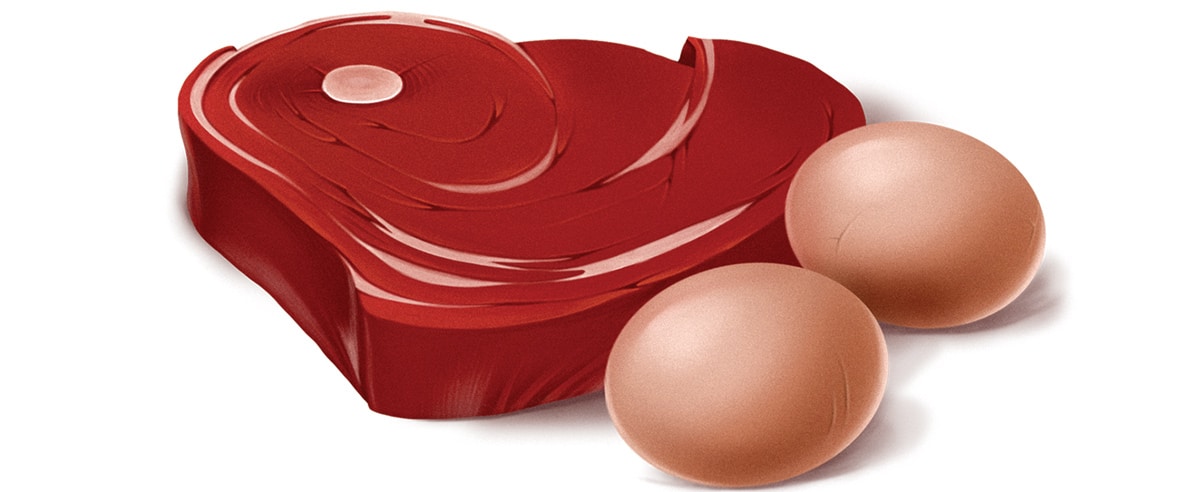
If you poke around raw vegan corners of the internet for long enough, you’ll almost certainly come across the idea that humans aren’t evolutionarily designed to eat meat. The theory is that since humans and other primates evolved from a common ancestor, then humans, like other primates, are primarily designed to eat plants.
Well, first of all, other primates do actually eat meat, and quite a bit of it. But more importantly, whatever might be true about apes or chimpanzees, there’s an overwhelming amount of evidence that humans evolved as omnivores, animals that eat both meat and plants. (If you want more on why we're not actually evolutionary "designed" to be vegans, go here). And meat was important for making us human in the first place, especially for our huge, calorie-sucking brains.
The brain of a modern human needs about 20% of that person’s calorie intake, and also demands all kinds of nutrients, from Omega-3 fats to B vitamins. We simply couldn’t have evolved such a demanding organ without meat to provide calories and important nutrients.
A couple recent studies have looked at the way meat contributed to the evolution of the human brain, so it’s a good time to take a look. How did we evolve as omnivores, and how did meat contribute to our evolutionary development, especially those calorie-guzzling brains? And today, when it’s more than possible to get plenty of calories from plant foods alone, do we still need meat to survive?
Meat and Human Evolution
From around 6 million years ago to 2 million years ago, the ancestors of modern humans had pretty small brains. For about 4 million years, our brains were basically the same, and pretty unimpressive by modern standards.
But then we started eating meat. The ancestors of modern humans started eating meat around 2.5 million (2,500,000,000) years ago (for reference, the Agricultural Revolution, when we started eating grains as our staple food, was only around 10,000 years ago). With the introduction of meat into our diets, our ancestors’ brains started rapidly increasing in size and complexity. This allowed early hominids to develop into modern humans, with the brainpower to do things like create computers and fly to the moon.
This dramatic effect of meat on brain evolution is sometimes explained just in terms of calorie density, but it’s actually more complicated than that.
Meat Provided Calories and Nutrients for our Brains

If you look at the calorie density of foods that were available in large quantities in the Paleolithic, fatty meat is at the top of the list. Animal foods gave us the calories we needed - especially the calories we needed for our enormous, energy-sucking brains.
That was especially true after we learned to process meat. Carnivores like cats and wolves have teeth that just tear right into raw meat, but humans typically struggle with it, so we had to put those big brains to work figuring out how to feed themselves. We started out by simply cutting raw meat into pieces - this made it easier for our relatively weak teeth and jaws to manage (think of how much easier it is to eat sashimi than it would be to bite into a whole raw tuna fish). Then we started cooking it, which gave us even more calorie value from an already calorie-dense food. The more we used our brainpower to process meat, the more calorie value we got from the meat, and the more our brains could grow.
But meat didn’t just provide energy. It also provided essential nutrients. In fact, there’s even an interesting theory that Vitamin B3 might have been a limiting factor for our brain development - eating meat provided a steady source of Vitamin B3 that allowed our brains to grow. Another important set of nutrients come from seafood. Access to seafood like fish and shellfish might have also allowed our brains to grow bigger because fish and shellfish provided dietary sources of Omega-3 fats and important micronutrients for babies’ growing brains. This may have made it possible for babies’ brains to grow as fast as they needed to.
Remember that humans are omnivores, not just carnivores. Meat didn’t just add nutrient value to our diet; it also increased the value of our plant foods. Once we could eat meat and get nutrients like iron, potassium, and B vitamins from meat, we could also fill up our calorie needs with nutrient-poor plant foods when necessary, without suffering from deficiency diseases.
Humans evolved as omnivores - animals that eat meat and plant foods. With all due respect to the vegan crowd, our digestive systems are not actually designed to eat a diet only of raw fruit or vegetable foods. The addition of meat to our ancestral diet allowed us to evolve into the small-mouthed, big-brained creatures that we are today.
Do we Still Need Meat?
OK, so we evolved with meat. But you know what else we evolved with? Constant parasite infections. Just because we evolved with something doesn’t mean we necessarily want to keep doing it. And today, those meat-fueled brains are advanced enough that we can invent ways to escape the need for meat in the first place: it’s possible to live as a vegan thanks to modern inventions like synthetic B12 supplements. So is it still beneficial to our brains to keep eating meat?
Calorie Density
If we’re just looking for a calorie-dense staple, then no. Meat isn’t even the most calorie-dense food around any longer. Grains are more efficient at delivering calories than most types of meat.
But today, most people aren’t struggling to get enough calories. If anything, they have the opposite problem: too many calories, especially from nutrient-poor refined grains. That kind of calorie overload doesn’t help your brain get bigger, and it might actually do a lot of damage. Poor blood sugar control caused by a diet high in refined carbohydrates can actually contribute to degenerative brain diseases like Alzheimer’s disease.
Using animal foods as staples can help control hunger, reduce overeating, and avoid dangerous spikes and lows in blood sugar. So meat might still be useful as a calorie source for our brains, but for the opposite reasons. Back in the day, meat optimized our calorie intake by making sure we had enough. Now, it might help optimize our calorie intake by making sure we don’t get too much, and by providing a source of calories that helps with good blood sugar control.
Nutrients
And remember that meat doesn’t just provide calories. Meat was also critical for human brains because it provided important nutrients that allowed us to develop such complicated, nutritionally demanding, and finicky thinking machines.
Even today, animal foods still provide important nutrients for mental health, some of which are only found in animal foods (or are found in such small amounts in plant foods that it doesn’t really count). Vitamin B12 is a good example: it’s critical for healthy brain function, and it’s only found in meat, eggs, and dairy. There are no natural vegan sources of vitamin B12 - vegans have to take synthetic supplements. Seafood also supplies important brain nutrients like omega-3 fats.
It’s possible to get these from supplements, but we’re just not very good at making the right supplements yet. For example, omega-3 supplements don’t even come close to the health benefits of eating actual fish. The animal foods we evolved with still have an edge over even the best nutritional substitutes we can invent.
For Now, At Least, Meat is Still Brain Food
Maybe in the future, we’ll come up with supplements so good that they’ll give us all the benefits of animal foods in a pill, without any of the problems of factory farms, methane, or overfishing. But our brains evolved on animal foods, and for now, animal foods seem like our best bet for keeping them happy.





Leave a Reply